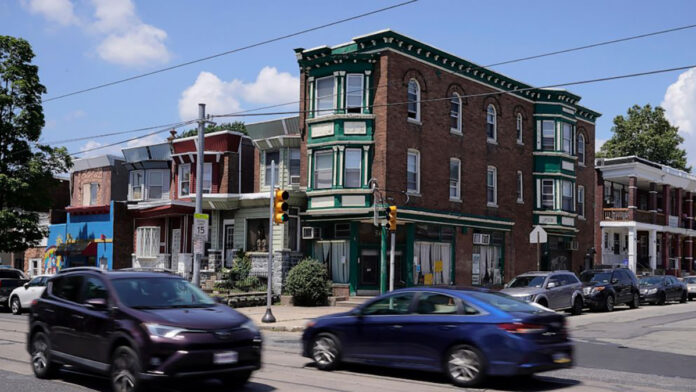
In the weeks before Kimbrady Carriker opened fire at random with an AR-15 in southwest Philadelphia killing five people and wounding four others including several children, the few people close to him had watched him grow increasingly agitated and erratic, sometimes pacing the house wearing a bulletproof vest, prosecutors and others have said.
Now, in the wake of Monday’s bloodshed, officials are urging people to call police or the city’s mental health resource line when they see suspicious social media posts or think somebody might need help. And as Carriker’s possible mental health issues increasingly come into focus, the community he left shattered is trying to find ways to heal their own psychological trauma.
Prosecutors earlier this week declined to speak to whether Carriker’s mental health played a role in the shooting. No one called to report his erratic behavior, and Carriker did not leave a long history of brushes with police or behavioral health crisis providers.
But posts on Carriker’s Facebook page, which has since been taken down, showed a fervor for guns and self-protection and mentioned community patrols he had gone on seemingly alone. Other recent posts shared articles about what to do if you think an evil spirit is following you.
The 40-year-old is charged with five counts of murder, attempted murder, aggravated assault and weapons counts. Family and previous roommates have declined to comment or not returned phone messages left by The Associated Press.
“If we are talking about somebody who is armed and not in their right mind and capable of doing harm, the option is to call 911,” said Chief Inspector Michael Cram, with the Philadelphia Police Department’s Homeland Security Bureau. “There is no better option if someone is in that type of crisis.”
Cram heads the department’s new Behavioral Health Unit, which was started late last year. It includes a new co-responders program that pairs police officers with clinicians to respond to calls where someone might need behavioral health services.
It’s one of a handful of directed efforts from the city and the police department to better address mental health concerns in the community.
More than 2,000 of Philadelphia’s roughly 6,000 police officers have gone through Crisis Intervention Team training— a 40-hour module on mental health issues and how to respond to someone who is in a crisis, Cram said.
Operators at the city’s 911 call center also receive that training to be able to identify calls that might be better suited for mental health professionals.
Jill Bowen, commissioner of Philadelphia’s Department of Behavioral Health and Intellectual disAbility Services, said the city amplified its efforts to build out its behavioral health crisis system after the killing of Walter Wallace Jr. in October 2020 and the protests that followed.
Wallace’s family called for help because he was in the midst of a mental health episode. When two Philadelphia police officers arrived, they found Wallace armed with a knife. He refused commands to drop the weapon and amidst pleas from his mother to stop, the officers shot Wallace multiple times. Cellphone video captured the encounter and spurred protests throughout the community.
Bowen said since 2020, calls to the city’s crisis services number and 988— the national suicide and crisis prevention hotline that went live last year— have increased every month.
The city has added a mobile crisis unit, which sends people from or familiar with the communities to respond whenever possible, and distributed many trauma cards, which outline local resources and other information, she said.
“You don’t have to wonder should I call? Or is this the right number? Just call. Whatever the question or need is… they will direct you appropriately,» Bowen said
Meanwhile, in the days immediately following the shooting, the streets in the Kingsessing neighborhood were largely quiet — under a blanket of collective trauma. Community organizations and faith leaders wondered how they could give people a safe place to heal when such a large swath of the neighborhood had become a crime scene.
The victims: Lashyd Merritt, 21; Dymire Stanton, 29; Ralph Moralis, 59; Joseph Wamah Jr., 31; and DaJuan Brown, 15, were killed while they were going to the store, visiting their grandparents, headed out to meet friends and living their lives.
Rev. Cean James of the Salt & Light Church, which is a few blocks from where the shootings took place, opened his doors the next morning to anyone. He’s hosted vigils and invited both congregants and people outside the church to speak to a counselor or spiritual advisor on staff to process the shooting.
“There’s an old saying in the African American community that Black people don’t go to therapy, they go to church,” James said. “A few years ago, I started wondering, what if people could go to church for therapy?»
One of the pastors in the church has a Ph.D. in mental health counseling and the church pays for his services so that people can see him free of charge. James said the cost of counseling is prohibitive to many people in the community, and a lot of Black people have also had negative experiences with counselors that did not understand them, their culture or their community.
James said he thinks people have started to feel a return to safety, in part because of having a safe space to talk and grieve with neighbors, but also as more information is released about Carriker and the seemingly isolated nature of the shooting.
“People are out more than normal really (Friday), out comforting each other, talking with each other, being community for one another,” he said. “This is a strong and resilient community.”






